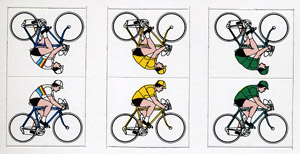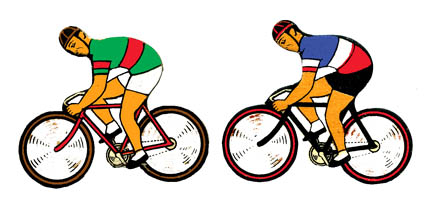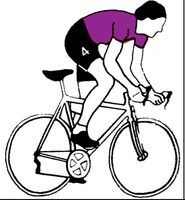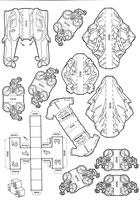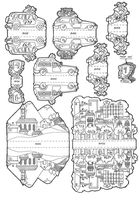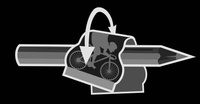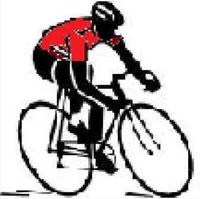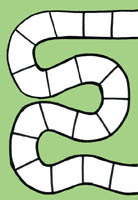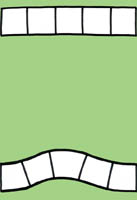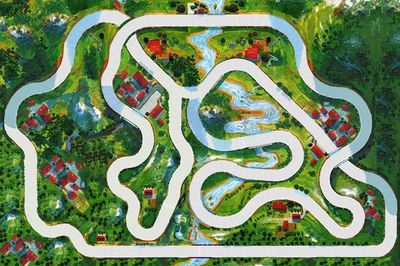MAKE YOUR OWN CYCLING GAME
So you are planning to make your own cycling game. Welcome!
You know everything about cycling games, you have lots of ideas, most of which are better than everybody else's. You probably do not need any help. I am glad for you. Nevertheless, I do offer some help.
First thing you should know: there are LOTS of cycling board games around. More than 150 are included in this site (so far) and I have information about at least 200 more. What's worse, there must be thousands of unpublished cycling games. A friend of mine who worked in the game industry in Spain in the beginning of the eighties, told me that they received a prototype for a cycling game every week.
Next thing you should consider is what are you going to do with your game when it is ready. You can try to sell it to a game publisher, publish it yourself, or make a print-and-play game (either free or for a fee, your choice).
There are many websites that offer advice to game designers, as well as many interesting stories. Here is a short selection:
http://www.xs4all.nl/~mgsch/gaming/concepts/games_concepts.htm
http://www.sloperama.com/advice/lesson20.html
http://www.spotlightongames.com/list/design.html
http://www.thegamesjournal.com/
http://www.bgdf.com/
Testing
One more piece of advice. Test the game. It sounds obvious, doesn't it? Well, go and test it again, with different players, of a different age. Test it with people who love cycling races, test it with people who do not. Test it with people who love playing games, test it with people who do not (if you can get them to play!). And remember, playing a multiplayer game against yourself is not properly testing a game. I cannot insist enough on this point. You would not believe the quantity of under-tested games that there are. And most of them are flawed games.
Print and Play or boxed games?
I generally prefer to make print-and-play games (like Pistard), but I once made a boxed game too... Let me tell you, it takes a lot of work, and quite a lot of money. When people ask me what is the most expensive game in my collection, I always answer "Maillot Arc-En-Ciel, of course". I would never have paid for any other game the amount I spent on the game development (even without including some trips to meet people who would test the game, which took me as far as Belgium -1500 kms away from home). My idea with this game, nevertheless, is to make it a free print-and-play game when I get rid of the few physical copies left. (So, if you want one, hurry up, I am selling them at 50 euros and I am losing money).
The name of the game
Please be original! There are already too many games called "Tour de France" or "`L'Échappée Whatsoever". Check our alphabetic list to know what is already taken (and keep in mind that this is just a list of the games in this website. As I said above, there are many other cycling games).
Game rules
The rules of the game are probably the most important part. I do not doubt that you know what you want, and that you have a fantastic idea for the rules of your game. Anyway, just in case, here is my advice: read as many games' rules as you can. It might be good to get some ideas, or to see whether your ideas are really original. Here ("Cycling Board Games, the text") is an essay I wrote some years ago about cycling games rules. Although I have not updated it in years (adt therefore it does not include recent innovations) it's probably the best compendium of cycling games' rules you will be able to find. Instead of updating the old text, a few years later I wrote another -unfinished- text with more advanced ideas ("New Directions in Cycling Board Games") that you also might want to check.. Other good sources for games' rules are Boardgamegeek or François Haffner's JeuxSoc. By the way, read the rules of as many racing games as you can, not only cycling ones.
Another important point is writing down the rules. It is more difficult than it seems. Keep that in mind and ask all your friends to check them for clarity and coherence. Feel free to send them to me if you need a second opinion. (I read English, Spanish, Catalan, French, Italian and Portuguese. Probably Occitan too. On the other hand, my German or Dutch are too poor to fully understand games rules. Keep that in mind).
Dice
Among the many websites that generate random dice throws, rolladie.net is fine and versatile enough.
Counters
Since you want to make a cycling board game, it is quite probable you will need some cyclist shaped counters. Of course, you can use any other kind of counter, poker chips, bottle caps... but it is nice to have cyclists.
If your game has more than one cyclist per team, you will probably have to differentiate them somehow. Most common strategies are: numbers (like real teams, after all), couloured base or cap (maybe matching some other element in the game), position on the bike (quite rare)...
It is very important to keep in mind that the bigger the riders, the bigger the board (and the table) you need. What's worse, bigger riders are less stable! I have seen may cycling games finish after the third unwanted massive fall!
Basically, at this stage of development, there are three things you can do:
a) Use riders you have at home, from some other games or your childhood collection.
A good option is to purchase games and use its parts to develop a new game. In the lists section of this website you can find a list of available games. For instance, Criterium, L'Echappée Infernale or Magnytour offer a fair supply of Cofalu riders. Maillot Arc-En-Ciel will provide 43 small coloured cyclists and 120 colour-matching round counters. Velomaster is not a bad choice either. And of course, a game like Sprint, if you can find it, will provide lots of (bigger) riders and also track parts, almost everything you need to develop a cycling game.
In case you need smaller riders (which is quite common for starting game designers), you can try Leader 1 (or his twin Giro d'Italia game). The riders are surely small and the game is easily available, but the riders are not exactly what I would call "prototype-friendly". Too fragile for my taste, and the game quite expensive if you are going to need more riders (or replacements for broken ones). A good choice might be MB's Tour de France. It features 14 small (22 mm) riders (3 each in 4 colours plus one each yellow and green). Of course the game is not published anymore, but it is not too difficult to find on eBay, where you regularly find cheap copies.
b) Use some riders that you can print and cut.
Here are some models to download, print and cut. Just click on the images. Some of them are taken or adapted from existing games, which makes them OK for purposes of game-developing, but may not be suitable for distribution. Please check the copyright notice at the bottom of this page. Of course you will need some image editing software to change sizes and colours.
Pistard riders. You have 16 riders in 4 colours, each with a different colour base.
You will also find 20 riders in 5 colours (without the coloured bases) in the p'n'p version of Jagd Über Etappen.
Coloured and blank models for Claudio Vianini's Corse Ciclistiche. Please follow the links and download it from his site.
5 riders from the 45 tours de France game.
A hi-res scan of an original uncut rider from Criterium de la Mère Picon. Just one, though.
Left: Four riders from Criterium de la Mère Picon ready to cut and assemble. Original colours.
Right: Four more riders in new colours, not featured in the original game.
All 33 riders from Criterium (the Spanish 1979 game) ready to print and cut. You will need a base, though.
Two riders from Le Jeu du Veldiv. These are not ready to print and assemble. They might require some work if you want to use them.A set of 8 riders adapted from El Juego de la Vuelta Ciclista. The originals featured numbers on the shorts, but this adapted version does not.
These are 3 new teams from Luke Morris enjoyable "Tour" game. The game, as you may know, is not free, (don't ask me for the other files) but these three teams are a bonus which can be freely downloaded from BoardGameGeek.com
There is also the option to make flat riders. These are the 16 riders in La Serpiente Multicolor. Of course, you can also download the complete game and get some nice tracks.
Finally, there are some more unconventional options. Here is a scan of the 20 Course de la Paix stickers. Not a solution I would use, but maybe what you need.
Set of 32 riders (8 colours, 4 card suits), pistard-style. What would you need these for? Use your imagination!
Another set of 32 riders. This one is adapted from El Juego de la Vuelta Ciclista. Here are 8 teams of 4 numbered riders.
Two sheets ready to print, cut, and paint, to make your own 1990s-flavoured cycling race. They are adapted (er...) from the game Construye tu carrera de bicicletas.
Personalized vintage teams of 9 cyclists designed by Ricardo Ferrand for the game Pro Tour.
Four teams of four numbered cyclists in two different sizes (45/25 mm), originally created for the game Pignonfix. Derny included.
Twelve teams of five riders (plus 9 special riders with leaders' maillots in case you need them) are included in the game Blazing Wheels.
Use the heaviest paper your printer can accept (I use 250 g/m2) or paste the riders onto cardboard.
c) Buy some of the currently available riders.
After all, using real cyclists is nice. Unfortunately I cannot provide a link to download them ;-) but I can tell you where you can find them.
These plastic counters may not be the most beautiful, but they are cheap, available in many colours, and very stable on a game board (Here or here or here or here are sites where you can buy them, as well as many other game parts). They are used in many modern games. You probably have some at home, or else you can buy Maillot Arc-En Ciel and get 43 in six different colors. They measure 3 cm.
These measure 3.5 cm and are available from the Fonderie Roger, either painted or unpainted . They were once made for a board game. There are three different positions, which may be helpful for some games. Unfortunately, they are not too stable on a board (except maybe the "sprinter" position, which is acceptably stable)
These measure 5 cm and are also available from the Fonderie Roger, (again, painted or unpainted). They are a very good option if you are making a one-off prototype, since they are solid and stable, but they are probably too expensive if you are going to make many copies of your game. (Check Roger's website for more possibilities)
These modern Norev riders are smaller (ca. 1:43) and although they were probably not dsesigned for their use in games, they are an option. They can also be found in different sites (for instance, here: http://www.sportgoodies.fr)
Of course, if your ideology does not say otherwise, you can also check the big general online stores, be it the one with the name of a river, or the chinese site which starts with the same letter, or even the famous auction site that sells lots of stuff that is not auctioned. There you might find, for instance these small, unstable, but quite cute and cheap riders, which are probably leftovers of the production of Leader 1- Hell Of the North)
These measure 6 cm and are made in France by Cofalu/Multiplay. Although they are (and look) quite old, you can still find them. However, I do not recommend these riders: Although they look nice on the board, they are too big (you will need a very big board) and quite unstable.
You can also check eBay for second hand cyclists. It used to be an option, but old riders (like this Spanish Sotorres) have become increasingly expensive in the last years.
The boardSo far, we have not discussed if you want to make a track cycling game or a road cycling game (or even a cyclo-cross or mountain bike game).
While almost any track cycling game will provide a workable cycling track (depending on the number of squares you need, see below), developing a road cycling game may need more flexibility. A number of games offer modular tracks which you could use to design your own game. Unfortunately, most of these games are hard to find and/or expensive. I am thinking of games like Sprint, Domenica Sportiva, Kleo's huge Tour de France or El Juego de la Vuelta Ciclista. Easier to find, Leader1 is not a bad choice, as long as you do not mind using very small riders. And of course you can use Flamme Rouge.
Nevertheless, while purchasing riders might be a good idea even in early stages of a game development, my advice is that you make your own board prototype, considering you will need to modify it more than you probably think (trust me!).
By the way, if you want it to look more "professional" here is a nice site where you can buy blanks to assemble a board (and many other game parts).
Click on the thumbnails to download ready-to-print black and white road segments (5 squares long)
Not really necessary, and not so easy to print, but I have also added matching 10-square-long segments:
Anyway, making your own prototype is not really hard. Here is the first draft I made for Maillot Arc-En-Ciel. In case you want to use them, click on the images to download ready-to-print A4 images...
Finally, here are four huge boards adapted by Michael McKale form those in Giro d'Italia Big Jim. Click on each board to download a multi-page ready-to-print pdf file.
Velodromes
Of course, maybe you prefer track cycling... Click on the images to download nice big jpg files, or on the links to download ready-to-print PDF files:
30-square-long track, ready to print on three A4 sheets. Suited to play Devil Takes The Hindmost, some games from "El Corriere dei Piccoli" (both Guido Crepax's and Piero Savi's), and many other...
40-square-long track.
60-square-long track, adapted from the game Bahn-Radrennen.
80-square-long track, with lanes for a change. Inner lanes are shorter. Make your own rules for this one or try to guess what game it is adapted from.
> PDF small (4 A4s)
> PDF big (6 A4s)
> PDF extra big (12 A4s)
Free cycling board games to download
Of course, all Print-And-Play games provide tracks and riders. Since these games are supposed to be printed in an A4 home printer, their tracks are almost always modular, which makes them quite good to develop your own game. Check my copyright notice below, though.
Click here to follow to the Print-And-Play games section.
Free Software
If you use the tracks and/or riders I offer, you may want to make size and colour changes. When you write the rules, you will want to offer them in a non-modifiable format, such as a PDF, etc... Generally, when you make something available to the public, you don't want to use proprietary formats as Microsoft's Word.
Of course you will do what you want (or what you can), but I strongly advice to use free software. Here are link to some recommended free software:
GIMP: Image Manipulation Program, a free raster graphics editor used to process digital graphics and photographs. It is a good free software replacement for Adobe Photoshop.
LibreOffice: Free cross-platform office application suite available for a number of different computer operating systems. It supports the ISO/IEC standard OpenDocument Format (ODF) for data interchange as its default file format, as well as Microsoft Office formats among others.
PDF Creator: An application for converting documents into Portable Document Format (PDF) format on Microsoft Windows operating systems. Once installed, it allows the user to select PDFCreator as their printer, permitting almost any application to print to PDF.
PosteRazor: Converts an image into a multi-page PDF which can be printed out and assembled as a poster. Nice tool for creating game big boards with small printers.
Anything else you need can be easily found on the internet. Among the many free software directories, I would recommend this Wikipedia page as a good place to start.
Copyright is a tricky subject. Most people only worry about it when they have something to protect. What's worse, most people tend to think that they have more rights than they really have, and tend to get paranoid about this subject. As far as this site is concerned, the situation is the following:
(a) It is perfectly safe to download the contents of this site and use them for your own private use, including semi-professional uses as game developing.
(b) Be aware, though, that if you are going to publish a game that you have developed using parts of which you do not own the copyright to, you may have to change the design before the game is published, or else contact the copyright owner of each part you have used, and reach a deal with every one of them.
(c) On the other hand, if you think you own the copyright to some of the parts we have used in this website and that we should withdraw it from the site, please contact us (and we will probably convince you that you are wrong).
One final word (two, actually)
There as many approaches to making your own game as there are game makers, fortunately. Check the unpublished games section for ideas.
By the way, except when otherwise stated, the stuff in my site is either picware or emailware (or even both at the same time, when possible). What does that mean? It means that if you use information or pictures from this site, specially from this "make your own games" section, you MUST either:
a) send me pictures of your game
b) send me a link to wherever you posted the pictures
c) or at least send me an email so I feel it is worth to keep working on this site.
CULTURE
IDEASTOTUM REVOLUTUM
THUMBNAILSNAMES
ALPHABETICALCATEGORIES
LISTSWHAT'S NEW
BLOG




